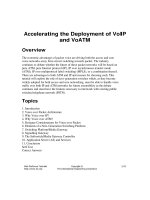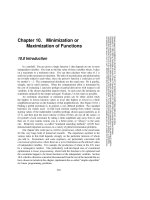Tài liệu CURRENT R&D OF ADVANCED ROBOTS IN CHINAREPORT TO JCF’2002 OF IARPSOME CURRENT DEVELOPMENTS ppt
Bạn đang xem bản rút gọn của tài liệu. Xem và tải ngay bản đầy đủ của tài liệu tại đây (2.05 MB, 7 trang )
CURRENT R&D OF ADVANCED ROBOTS IN CHINA REPORT TO JCF’2002 OF IARP
- 1 -
SOME CURRENT DEVELOPMENTS OF ADVANCED ROBOTICS
IN CHINA
Xianzhong DAI
Robotics Expert Group of National High-Tech R&D Programme, China
Frascati, Italy/Nov. 8, 2002
1. Preface
As a part of the National High-Tech R&D Programme of China, the Subject Topic of Robot
Technology mainly covers the key techniques of robotics and launched in the first year of the
National Tenth Five-year Plan, or 2001. The Subject Topic during the Tenth Five-Year Plan focus
on the R&D key technologies and prototypes of advanced robot
ics such as humanoid robots and
bionics robots, mobile robots, medical robots, pipe robots, network-based robots, micro-
manipulation system
s, service robots, robots technologies in agriculture and forest, and so on. And
some
innovation achievements of which have been obtained in the passed years. In this
report, some current R&D of advanced robotics in China will be introduced briefly with the
following sequence,
Wall-climbing robots;
Humanoid robots;
Medical robots;
Micro-manipulation systems;
Mobile robots;
Underwater robots.
2. Wall-climbing robots
The wall-climbing robotics study in China has got developed very rapidly,
although it started relatively late compared with other advanced countries. With the
support of the National High-Tech R&D Programme, the Robotics Research Institute
of Harbin Univ. of Tech., Shanghai University, Beijing Univ. of Aeronautics and
Astronautics and so on, began to do such research one after other. Some period results
have been achieved, for example, the Robotics Research Institute of HIT has
successfully developed two series and five types of wall-climbing robots, which are
based on negative press absorption and magnetic absorption, respectively.
At present, the main use of wall-climbing robotics techniques is the construction
cleaning. In this kind of practical use, the wall-cleaning robots made by the Robotics
Research Institute of HIT and the Institute of Robotics Research and Beijing Univ. of
Aeronautics and Astronautics representatively are being put in market by some
cleaning companies. Fig 2-1 shows the wall-climbing robot which made by the HIT
Robotics Research Institute .The robot consist of a main frame, cleaning mechanism,
remote controller, safety and protection device and other mechanical parts. It can be
used to clean ceramic tile, marble or glass wall surface etc. With the adoption of the
negative pressure absorption technique, the robot can be tightly absorbed to the wall.
The robot is droved by two wheels and can be moved on the vertical surface. With a
built-in remote controller it is easy to be operated by a operator on the ground. On the
base of formerly research result, the HIT Robotics Research Institute succeed in
making a new washing robot for cleaning glass wall, show in Fig 2-2, the robot
adopted an electrical revolving brush in the clean mechanism, which can collect and
reuse the waste water.
CURRENT R&D OF ADVANCED ROBOTS IN CHINA REPORT TO JCF’2002 OF IARP
- 2 -
The institute of Robotics Research, Beijing Univ. of Aeronautics and
Astronautics has also done a project in the technology application of the wall-
climbing robot. The institute developed several types of wall cleaning robotics
systems. Fig 2-3 shows the glass ceiling robot developed for the Beijing railway west-
station, which is composed by two parts—the main body and the ground support
equipments. The main body can complete cleaning action as climbing task on the
glass wall, and it can also collect the wasted water. Fig 2-4 shows the newly
developed window-cleaning robot, it is a kind of fan sucking robot which has no
suction disk, spray spout and tracks, and undertake continuous cleaning work. The
robot can be controlled by the controlling box and the cable walking system stands on
the top of the buildings.
Nowadays in China, the application fields of wall-climbing robot is relative
narrow, however, we believe that with the developments of the robotics technique, the
wall-climbing robot can be used in more and more fields.
3. Humanoid robots
The first humanoid robot is build by National University of Defense
Fig.2-2 Photo of the new type robot
Fig.2-1 CLR-2 cleaning robot
Fig.2-3 Robot for cleaning station windows Fig.2-4 3W window cleaning robot
CURRENT R&D OF ADVANCED ROBOTS IN CHINA REPORT TO JCF’2002 OF IARP
- 3 -
Technology in 1999. This humanoid has total 18 DOF (Fig.3-1). Each leg of it has 6
DOF, and each arm has 3 DOF. The height of the humanoid robot is about 1.2m, and
the weight of humanoid main body including the mechanism, actuators and reduction
is about 40kg. The computer system and the power supply are separated from the
main body.
In 2001, a new humanoid project supported by the National High-Tech
Research and Development Programme was launched. Figure 3-2 shows the
humanoid robot BHR-01, which is developed at Beijing Institute of Technology.
BHR-01 Humanoid robot consists of a head, two arms and two legs, and has
total 31 DOF. The head of it has 3 DOF, each leg consists of a thigh, shank and foot
and has total 6 DOF, and each arm consists of an upper arm, forearm and hand, and
has total 8 DOF. All joints are driven by DC motors with a harmonic-driven reduction
gear actuates respectively. The computer system and power supply are integrated in
humanoid body. The height of it is 1.6m and the weight is about 80.0kg.
Fig 3-1 Humanoid by University of Defense Fig 3-2 Humanoid by Beijing Institute
Technology in 1999
of Technology in 2002
4. Robot-assisted medical mechatronics
Similarly in the developed countries, the requirement in china for medical robots
has been increasing year by year, as there would be so many reasons for this kind of
requirements, such as:
Since there is a problem of population, Chinese government has paied much
attention on the prophylaxis diagnosis of people’s disease;
China has about 80 billion RMB market with 10% increasing rate per year
and almost every hospital in large cities want to equip some high-tech
instruments e.g., CT, MRI, Image-guided navigation and even medical
robots.
Meanwhile, more and more attentions have been paid on R&D of medical robots
by most Chinese universities and academic institutions. For example, the
neurosurgery application research is in Beijing Univ. of Aeronautics and Astronautics,
Tsinghua Univ. and Navy Hospital of Beijing, the orthopedic application research is in
Shenyang Institute of Automation, the Chinese Academy of Sciences, and so on.
Among them, frameless stereotactic neurosurgery system has got great successful.
CURRENT R&D OF ADVANCED ROBOTS IN CHINA REPORT TO JCF’2002 OF IARP
- 4 -
The robot-assisted frameless stereotactic neurosurgery system (Fig.4-1) is
developed by Beijing Univ. of Aeronautics and Astronautics and has been used for
practical neurosurgery more than 50 cases in Navy Hospital of Beijing. As for the
conventional neurosurgery it needs opening the skull of the patient and so it needs
long time for convalescence, and also it depends on the surgeon’s experience to locate
the pathological tissues, which are normally not really clear. Discarding the
cumbersome frame, the robot-assisted neurosurgery system uses the markers for
registration. So it reduces the operation procedure and increases operation efficiency
and safety, and shortens recovery time for patient.
Fig. 4-1 The robot-assisted frameless stereotactic neurosurgery syste
5. Micro-manipulating robots
Some micromanipulating robots used for bioengineering and micro-assembly
have been developed in China, three examples and their recent developing.
5.1 Micromanipulating robot facing bioengineering developed in Nankai
University
A new type of biologic-medical experimental robot has been developed by
Nankai University, Tianjing. The micro-operation robot system consists of system
management module, micro-vision & image processing module, multi-axes motion
programmable module, and high precision motion control module. The operator can
control the motion of micromanipulator & micro-holder by computer. By means of
the micro-vision & image processing, the actions of micro-tools on biological bodies
can be performed with high precision automatically. The typical operation process can
be memorized and repeated automatically. There is a large operating space enough to
exchange the micro-tools and to search the operating objects conveniently. The micro-
tools can be searched and shown on CRT automatically, and the experiment process
displayed on CRT timely can be memorized. The system can be applied to some
micromanipulations of biological bodies such as trans-gene through micro-injection to
cells, micro-cutting experiments of the chromosome, and so on (As shown in fig.5-1
and fig.5-2).
CURRENT R&D OF ADVANCED ROBOTS IN CHINA REPORT TO JCF’2002 OF IARP
- 5 -
5.2 Micromanipulating robot system facing microassembly developed in
Harbin institute of technology
The tele-micromanipulating robot system based on microassembly has been
successfully developed in Harbin institute of technology. The robot is made up of 3
DOF master, a 3 DOF micromanipulor, a 6 DOF macro-positioning system, a micro-
gripper, a micro-vision system and a force perception system. It can perform visual
monitoring, visual feedback control, micro force perception and dual-arm
macro/micro tele-manipulation. Meanwhile, macro/micro force controller based on
impedance control is developed successfully. The peg-in-hole tasks are finished by
autonomic micro-assembly and tele-assembly respectively. In the tele-assembly
experiments, position trace and force trace are realized and the operator gained
durative and stable assembly force perception. The robot system will be applied to
micro-assembly of micro parts and MEMS parts (As shown in fig.5-3 and fig. 5-4).
5.3 Total optical micromanipulating system developed in University of
Science & Technology of China
In this system (as shown in fig.5-5) developed by
University of Science & Technology of China, Hefei,
the microgrip of cell and other particulates can be
realized by laser beams. Therefore non-contacting
operation occurs in the whole course of
micromanipulation. The optical micromanipulator—
optical tweezers and optical micromachining tool—
optical knife are integrated successfully in the system.
As a result, some micromanipulating and
micromachining tasks are performed. At the same time,
Fig.5-5 Total optical
micromanipulating system
200
µ
m
Fig.5- 4 Peg-in-hole is performed
Fig.5- 3 Micromanipulating robot system
based on microassembly
Fig.5-1 Micromanipulating robot syatem
b
ased on biolo
g
ical & medical en
g
ineerin
g
Fig.5-2 Micro-injection to oocyte of small
mouse
CURRENT R&D OF ADVANCED ROBOTS IN CHINA REPORT TO JCF’2002 OF IARP
- 6 -
micromanipulations or micro-machining are finished by coming into some
particulates’ bodies. But no spoiling occurs on the surface of these particulates. The
system is specially fit to manipulate and machine particulates (their size is sub-micro
meter to several decade micro meter) including non-biological bodies and live
biological bodies. Non-touching manipulating and controlling a big bio-molecules can
be performed by the system too.
6. Mobile robots
In recent years, more and more attentions have been paid on R&D of mobile
robots, for purpose of services and entertainments, both in Chinese universities and
academic institutions, e.g. the Institute of Automation, Chinese Academy of Sciences,
Shenyang Institute of Automation, Chinese Academy of Sciences, Shanghai Jiaotong
University, Tsinghua University, Southeast University and many others.
Most recently, a new type of mobile
robot named as CASIA-I(Fig.6-1) was
developed in the Institute of Automation,
Chinese Academy of Sciences, Beijing.
Using two DSPs, both TI’s
TMS320LF240X and TMS320LF 54XX
series on board, which greatly enhance the
signal processing capabilities for large
number of sensors, it is characterized by
with more useful functions and higher
intelligence for convenient use in offices,
families, hospitals, libraries and
exhibitions.
The outstanding features of mobile
robot CASIA-I lie in its attractive hearing,
speaking and conversing abilities. It can
hear and understand the operator’s oral
Chinese commands from a wireless
microphone, and then it will respond the
Chinese-based commands with both
Chinese-based speech system and
locomotion system. For example, after hearing the Chinese command “Turn to the
left”, it will response with Chinese words “No problem” and turns to the left in the
mean time.
7. Underwater Robots
After the research of 1000m and 6000m underwater robots, Shenyang Institute of
Automation, the Chinese Academy of Sciences are trying their best to carried out some
underwater engineering services. Besides researching and developing floating motion type
underwater robots, SIA now is developing a new type of underwater robot, which can walk and
manipulate underwater. Fig.7-1 is an developing underwater manipulating robot. It will be used to
lay and maintain cables under the sea.
Fig. 6-1. CASIA-I
CURRENT R&D OF ADVANCED ROBOTS IN CHINA REPORT TO JCF’2002 OF IARP
- 7 -
Fig. 7-1 Underwater cable-burying robot









